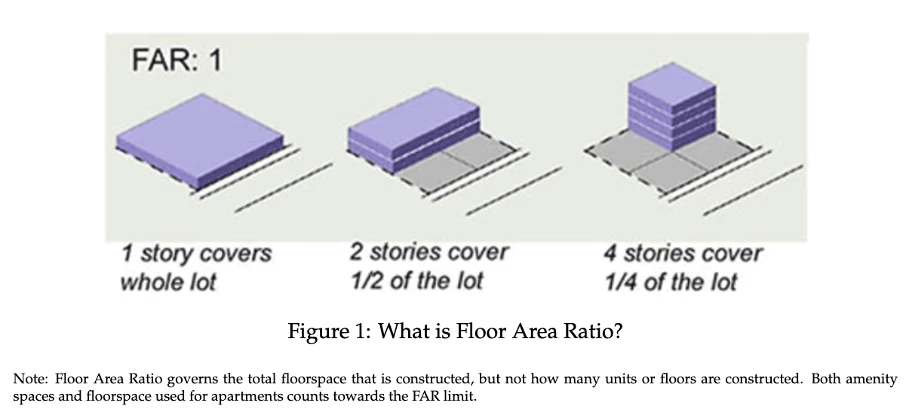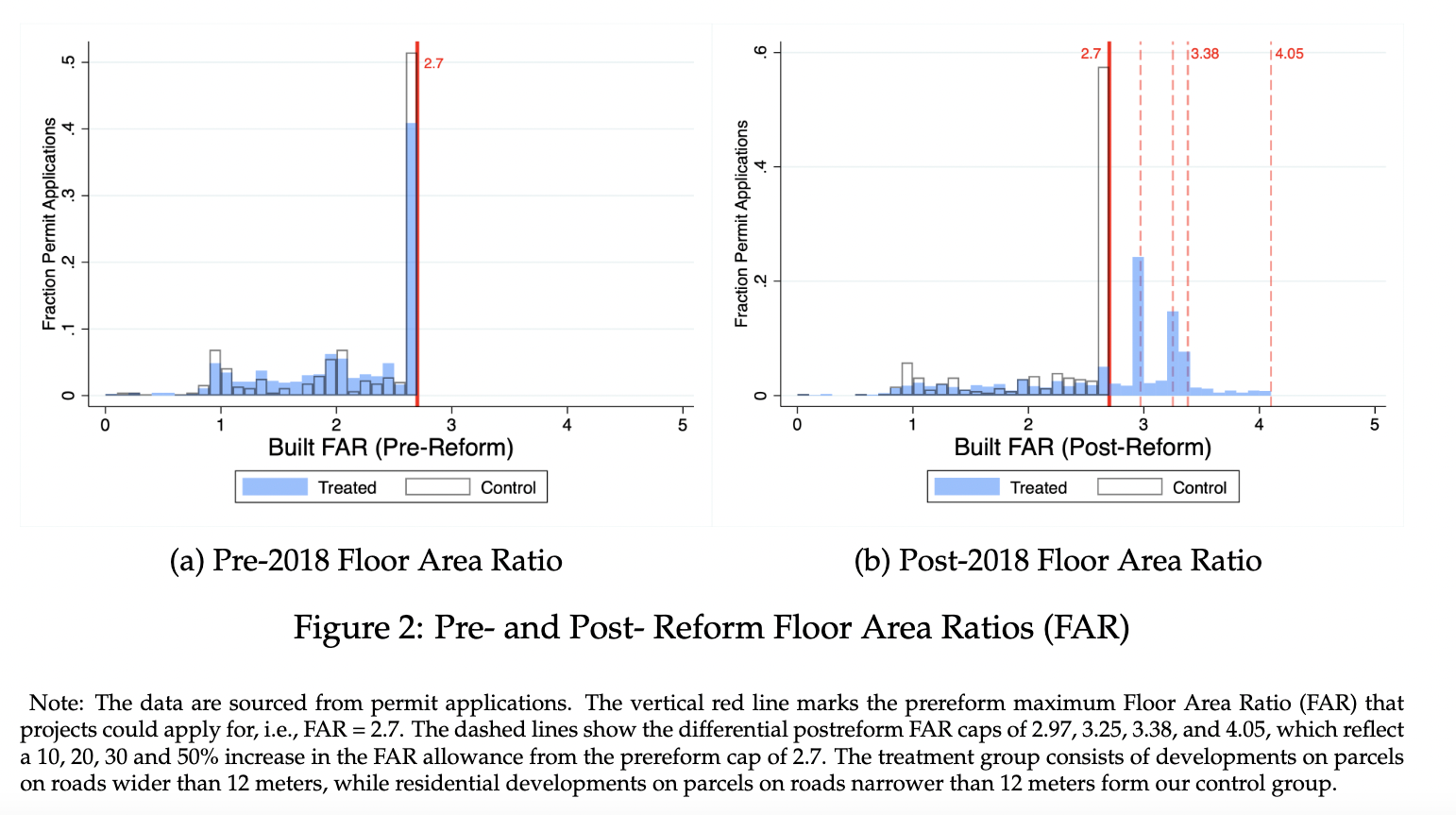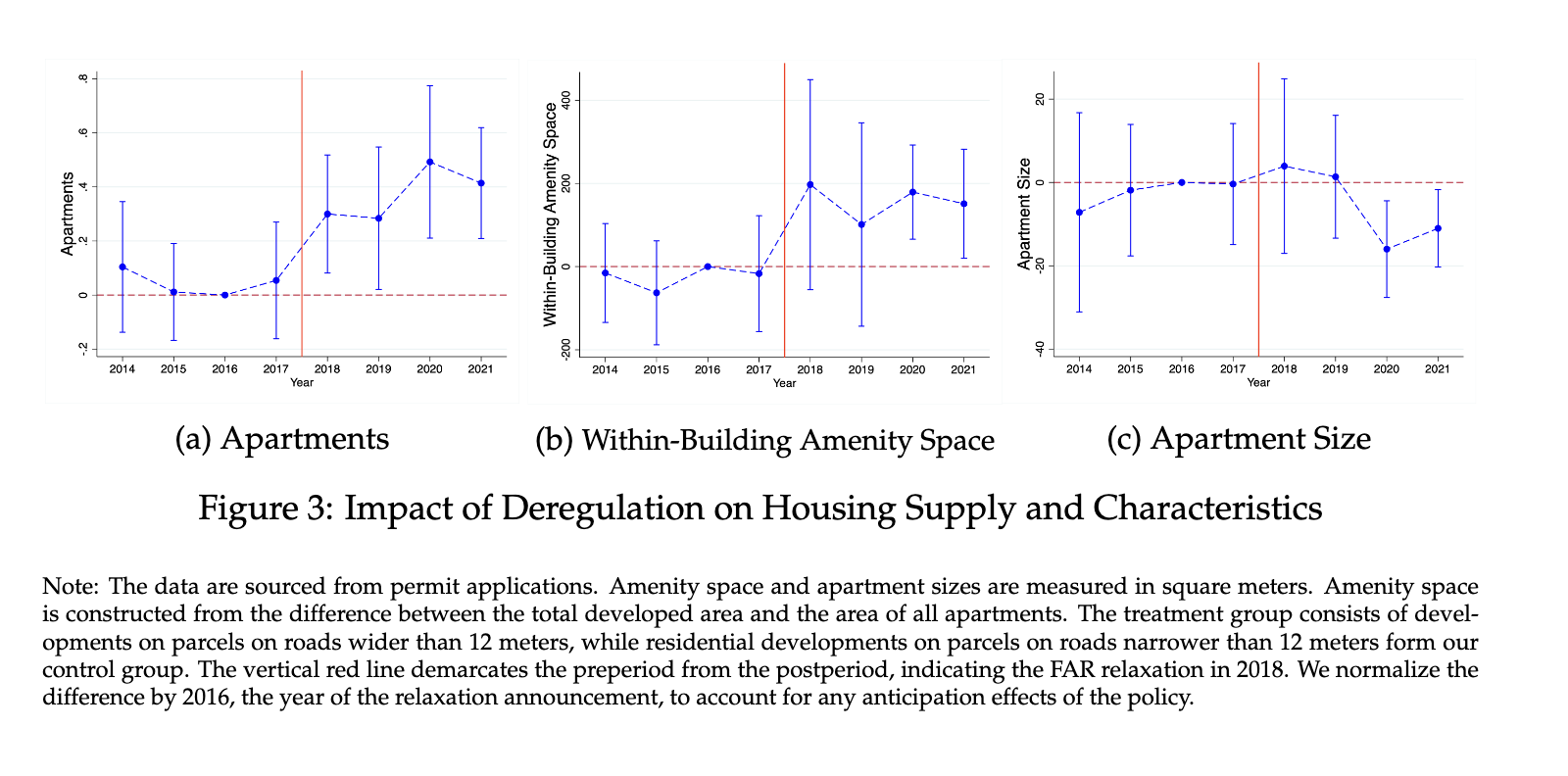This is the 25th in this year's series of posts by students on the job market.
Over two billion people will move into developing country cities by 2050, and India will account for a majority of this (UN, 2018). However, housing supply has failed to keep pace with this rapid urban growth, leading to an estimated housing shortage of nearly 20 million units and over 17% of urban India residing in slums. The scarcity of housing supply in Indian cities is attributed to stringent zoning regulations, primarily the Floor Area Ratio (FAR), which restricts how much floorspace can be developed on a given land size. Relaxing the FAR cap would allow for more housing to be constructed, but what type of housing?
A large literature in urban economics would suggest that allowing more construction would generate more affordable housing that would benefit lower-income households. However, opponents claim that this newly opened up floorspace would be used to supply luxury units leading to gentrification and would be unlikely to enhance housing affordability (Rodríguez-Pose and Storper, 2020). Similar opposition exists in Mumbai, India, although stringent FAR limits have been criticized for making housing unaffordable (Bertaud, 2004). My job market paper, co-authored with Sahil Gandhi, leverages uniquely detailed housing market data before and after Mumbai’s 2018 FAR relaxation to understand the affordability effects of relaxing building constraints.

Can relaxing building constraints lead to an increase in smaller, more affordable housing, or will it lead to the creation of large luxury units?
As shown in Figure 1, FAR controls the total floorspace that can be supplied on a plot but not how many apartments are constructed. Conventional urban models only account for housing floorspace. As FAR is relaxed and developers can construct more, it becomes cheaper to supply housing floorspace and therefore each buyer wants more of it. This would lead to larger apartments being provided.
However, this ignores that floorspace under FAR may be used for two purposes: to construct apartments and provide amenities shared by all apartments. While shared amenities are present in most multi-family developments across the world, and prominently advertised in classified ads, our paper is the first to think of them theoretically and empirically as a margin at which developers can adapt as building constraints change. Our model looks at amenities as public goods that have a fixed cost of provision for the developer, but yield returns from each apartment added to the residential development. The option to construct more makes it possible for the developer to provide more of both amenities and housing floorspace. However, as the number of apartments increases with FAR, within-building amenities become more profitable for developers to provide. This in turn allows housing space size to decline.
For example, let’s take a plot of 20 sqm with an FAR of 1. With 20 sq m, the developer chooses to supply 4 apartments of 4sqm each and 4 sqm of amenity space. Now, imagine the FAR doubles and the developer can build twice as much, i.e. 40 sqm. If the developer continues to supply 4sqm apartments, with 4 sqm of amenity space – they could supply 9 apartments. But with 9 apartments, an additional square meter of amenity space would take 1/9 sq m away from each apartment (as opposed to 1/4 sqm before the relaxation) and might yield higher profits for the developer. This would continue till both developer and households maximize their profit and utility respectively. This results in higher amenities but a lower housing size, an outcome which was previously unviable due to the FAR building constraint. Could they have built bigger housing instead? To take away a square meter of amenity space and add 1/9 sq m to each apartment would result in 3 sqm of amenities, and 4 1/9 sq m apartments. But that was feasible under the original floorspace constraint and not chosen, so that would not be an optimal choice!
Examining FAR relaxation in one of the world’s most stringently regulated cities: Mumbai
Prior to the 2018 relaxation, developers could construct a maximum of 270 sq m on a 100 sq m plot (i.e. an FAR of 2.7), a limit nearly a third of that in comparably dense U.S. cities. The 2018 reform provided parcels on roads over 12 meters wide with incremental FAR relaxations ranging from 10% to 50% (i.e. 297 to 405 sqm on a 100 sqm plot), while properties on narrower roads received no such relaxation.
We assemble three datasets to examine the impact of the deregulation on housing supply and affordability. To assess whether developers use the higher FAR limits and to quantify the consequent change in housing supply, we compile administrative data on the universe of residential permit applications in Mumbai for the period 2014 to 2022. Building plans filed with these permits contain detailed information on the characteristics of the housing to be constructed. Housing in Mumbai is generally in the form of multi-family residential developments, each with 45 units on average. We georeference each permit application and obtain unit-level data on sales prices from transaction records for the developments. Last, we obtain data on household characteristics using mortgage applications submitted to a large Indian bank.
Panel A of Figure 1 illustrates the stringency of Mumbai’s FAR before the 2018 relaxation. Prior to this change, almost half of the building permit applications were filed at the maximum FAR of 2.7. Panel b shows that permit applications on parcels affected by the relaxation in 2018 cluster at the new, higher FAR limits provided, whereas applications on parcels ineligible continue to be restricted at the pre-reform FAR limit of 2.7.

What happened after the FAR was relaxed?
Our reduced form specification leverages the spatial and temporal variation generated by this policy reform in 2018. We use a difference-in-difference design to compare developments between 2014 and 2021, on roads wider than 12 meters that witnessed a 10-50% FAR relaxation and form our treatment group. Parcels that are adjacent to a road narrower than 12 meters form our control group. Our identifying assumption is that there were no differential trends in the outcome variables between our treatment and control groups prior to the reform, and figure 3 shows evidence of this.
The FAR relaxation results in a significant supply response, driven by less expensive, smaller housing units. Our DID estimates show that the FAR relaxation resulted in a 28% increase in the average number of apartments in each treated development relative to the control (Panel a of Figure 3). This implies an elasticity of housing supply to FAR of 1.59. While most papers concentrate on the extensive margin of housing supply, i.e. the number of units supplied, our granular data lets us analyze the margins of developers’ response to FAR relaxation. We see that a part of the increase in the housing supply is driven by the provision of smaller units (Panel c of Figure 3). Households are compensated for this decline in housing size by an increased provision within-building amenities (like gyms and indoor play area for children) as seen in Panel b of Figure 3. This increase in supply and reduction in apartment size increases housing affordability with housing prices declining by 29%.

What can we say about the aggregate affordability effects of this relaxation?
To answer this question, we develop a structural model which allows us to quantify the spillover effects and changes in the composition of housing and prices that the reduced form does not address. It features households belonging to high- and low-income groups with different preferences for within-building amenities and unit size. The model matches reduced form moments observed in the data.
Lower-income households are willing to live in smaller apartments and derive higher value from these shared amenity spaces. Richer households also value these amenities but would much rather prefer to live in larger apartments. Since the FAR relaxation skews development towards smaller units with more amenity space, it attracts more lower-income households to move in. Consequently, we find that the average income of households moving into new housing after the relaxation was 3% lower.
Main Takeaways and Policy Implications
Our results show that contrary to what critics suggest, relaxing zoning regulations can lead to an increase in affordable housing supply. We show that policies concentrating FAR relaxation can draw in lower-income households driven by changing housing characteristics. As governments progressively implement zoning deregulation in cities worldwide, our paper sheds light on this additional channel that may need to be taken into consideration to maximize policy impact.
Geetika Nagpal is a PhD candidate in Economics at Brown University. Her work combines new sources of granular data, natural experiments and RCTs to understand housing markets and transit networks in India and Nigeria respectively. (Twitter: @nagpal_geetika)


Join the Conversation